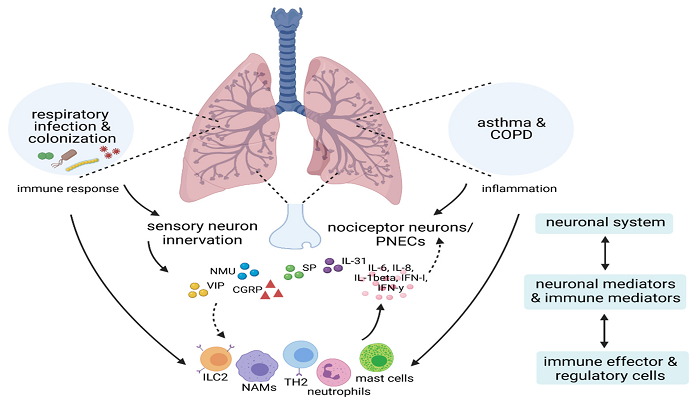Allergic asthma—which is characterized by wheezing and breathing difficulties triggered by inhaled allergens such as pollen, mold, and pet dander—is the most common chronic disease among children, and it can persist into adulthood. New research led by investigators at Massachusetts General Hospital (MGH), a founding member of Mass General Brigham (MGB), reveals how the relationship between nerves and immune cells in the lungs can contribute to the development of this condition.
For the study, which is published in the Journal of Allergy & Clinical Immunology, scientists generated unique newborn mouse models of allergen exposure that reproduce the progression of allergic asthma from childhood to adulthood. The worked involved tracking allergen-specific immune cells called T helper 2 resident memory cells (Th2-TRMs) that are known to be the central mediator of recurrent allergic inflammation in the lungs.
Experiments revealed that sympathetic nerves in the lungs produce dopamine and reside in proximity to certain T helper 2 cells following allergen exposure in newborns. When dopamine binds to DRD4 receptors on these T helper 2 cells, the cells are more prone to be transformed into Th2-TRMs and are instructed to produce immune response–stimulating molecules, or cytokines. Blocking this dopamine binding following allergen exposure in newborns reduced the T helper 2 cell transformation and alleviated lung inflammation upon the encounter of the same allergen during adulthood.
“Since human lungs are similarly innervated by dopaminergic nerves in early postnatal life, the dopamine-DRD4 axis may provide a therapeutic target to modify allergic asthma progression from childhood to adulthood,” says senior author Xingbin Ai, PhD, an investigator at MGH and an associate professor of Pediatrics at Harvard Medical School. “Dopamine signaling is likely one of many age-related factors that regulate Th2-TRMs in the immature lung. Moving forward, it will be important to further delineate the molecular and functional features of the pathogenic Th2-TRMs generated in the immature lung. A better understanding of the mediators of the early life Th2-TRM program could identify new therapeutic targets for the treatment of allergic asthma.”
About the Massachusetts General Hospital
Massachusetts General Hospital, founded in 1811, is the original and largest teaching hospital of Harvard Medical School. The Mass General Research Institute conducts the largest hospital-based research program in the nation, with annual research operations of more than $1 billion and comprises more than 9,500 researchers working across more than 30 institutes, centers and departments. In July 2022, Mass General was named #8 in the U.S. News & World Report list of “America’s Best Hospitals.” MGH is a founding member of the Mass General Brigham healthcare system.
Source: Massachusetts General Hospital


